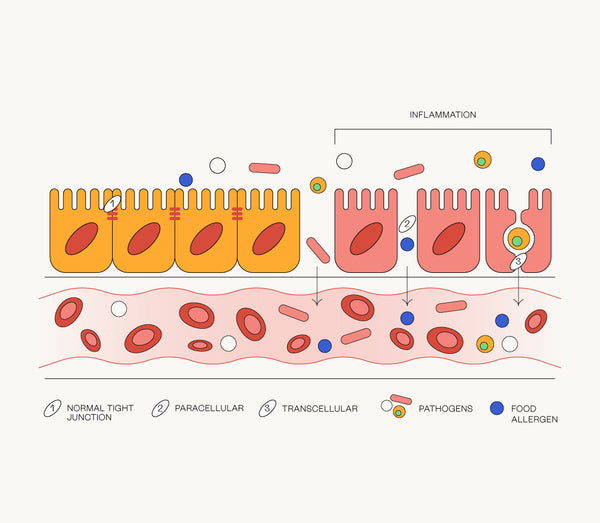If you want glowing skin, you’ll need to take care of your gut, here’s why.
Your Skin 101
When you think of organs you probably think of things like the heart, lungs, and liver, and you’d be right. These organs all have one thing in common, they’re inside the human body. But there’s one organ that’s external and it’s actually the largest of them all. The skin. The average adult carries approximately 2 square metres of skin, weighing around 3.6 kilos [1], and it has some pretty vital functions.
Structure of the skin
The skin is made up of 3 important layers:
- Epidermis - the top layer which we spend a lot of time, effort, and money trying to make look good but whose most important job is to provide protection from the sun, irritants, and pollutants.
- Dermis - the middle layer accounting for around 90% of the skin’s thickness. It’s where the sweat glands, sebaceous glands, and nerve endings are located.
- Subcutaneous layer - the bottom layer which is actually a layer of fat, known to help regulate body temperature, attach the dermis to bones and muscles and protect bones, muscles and tissues from injury [2]
Functions of the skin
- provides a protective barrier against pathogens, hazardous substances as well as injury
- protects the body from sunlight/UV radiation
- regulates body temperature
- prevents moisture loss
- sensory organ
- immune system organ
- produces vitamin D [3]
Now, you may have heard the phrase “beauty is only skin deep”, and there are elements of that statement that are true, but if you want smooth, supple, and blemish-free skin, it actually starts from within. What are we talking about?
Your gut microbiome, of course. When it comes to flawless skin, you’ll need to think about the health of your gut, and what you’re putting in it, too. Need a recap on the gut microbiome? Don’t worry, we’ve got you covered, check out our gut microbiome 101 page.
Your gut is crammed with microbes including bacteria, fungi, protozoa, and viruses which together, along with their genetic material, make up the gut microbiome. This collective ecosystem influences both your digestion and immune response as well as your overall general health.
I’ve Heard of the Skin Microbiome, What Is It?
The gut isn’t the only part of the human body that has its own unique microbiome. In fact. There are tiny, microbial ecosystems scattered across your body including, the mouth, lungs, genitals, and even the skin.
The skin microbiome consists of a milieu of microorganisms, most of which are either harmless or have some benefits for your health. Just like the gut microbiome, scientists have discovered there is a communication pattern between skin cells, immune cells, and bacteria that could be involved in:
- reducing inflammation
- strengthening the body’s deficiency system
- strengthening and repairing the skin barrier
The Gut-Skin Axis: What Is It?
The gut and skin share an intimate relationship, they’re like long distance best friends who influence each other's behaviour. Think about it like this: have you ever been ill, say with a cold or flu, and you look in the mirror and your skin looks dreadful?
We’ve all been there, but coupled with that is the fact you don’t feel up to eating much, perhaps you’re not drinking too many fluids either. Bingo! So your gut feels a little deprived, you’re feeling rough anyway, and your skin starts to take a beating, too.
This relationship in scientific terms is called the gut-skin axis and research is emerging that shows the gut microbiome can have an impact in some people with certain skin conditions [4].
Gut disorders like inflammatory bowel disease (IBD) and coeliac disease have been associated with skin issues such as erythema nodosum, where swollen fat causes lumps and bumps under the skin [5], dermatitis herpetiformis, a chronic condition caused by eating gluten [6], as well as psoriasis. Interestingly, psoriasis, a skin condition which causes red, flaky, itchy patches of skin, is more common in people with Crohn’s disease, a type of inflammatory bowel disease, than in healthy people [7].
How the gut exactly influences the skin isn’t completely understood yet but some studies suggest that intestinal bacteria produce neurotransmitters in response to stress which affects the skin [7]. The gut microbiome also produces short-chain fatty acids (SCFAs) which can modulate skin function, potentially leading to healthy skin.
A dysbiotic or imbalanced gut on the other hand, allows toxins, stress-induced neurotransmitters, and pathogens to enter the bloodstream and contribute to inflammatory skin conditions. It is clear that there is a complex interplay between the nervous, hormonal and immune systems as well as external environmental factors that are likely to contribute to the relationship between the gut and skin [7].

What Are Probiotics? Are They Good For Skin?
Probiotics have been shown to be a useful tool in preventing and treating numerous skin diseases, including:
- Acne
- Allergic inflammation
- Atopic dermatitis
- Eczema
- Hypersensitivity
- UV-induced skin damage
- Wound protection [8]
But what are probiotics? Well, actually we prefer to call them live cultures and they are live microbes found in foods, beverages, and supplements that could benefit your health. You can find out more about live cultures by visiting our Live Cultures 101 page.
There is a growing interest in the use of probiotics for various skin conditions, particularly as there are many ways that live cultures could have a beneficial impact on the skin, such as:
- reducing inflammation
- rebalancing the gut microbiome
- preventing pathogenic bacteria growth on the skin
- improve/maintain the integrity of the gut barrier
- lower the number of free radicals in the body
Incorporating live cultures, prebiotics or a mixture of the two (synbiotics) is a proactive way to take care of your gut and wider health. Taking care of your gut today is an investment for your future health. Fact. Consider live cultures/probiotics, prebiotics, and synbiotics as a part of your wider lifestyle. For example, you’ll need to take care of your diet, hydration, and be more active to unleash the microscopic magic within them.
Innate Co.’s Daily Synbiotic: An Alternative Festive Gift
This year, rather than spending a fortune on expensive skin care gifts with fancy formulas like hyaluronic acid or beta-hydroxy acid, why not treat your loved ones to an Innate Co. subscription?
A healthy gut is key to both physical and mental health, including your skin and our Daily Synbiotics is scientifically backed to help support your gut microbiome.
Our Daily Synbiotic is composed of 9 carefully selected bacterial strains, each with scientifically-backed health benefits. Our formula contains the following species which are scientifically proven to affect skin health:
- Bifidobacterium infantis - a study conducted in 2013 found that B. infantis supplementation for 6-8 weeks in psoriasis patients reduced pro-inflammatory biomarkers [9].
- Lactobacillus acidophilus - an Italian study involving 40 patients found that those who were given an oral supplement containing L. acidophilus and B. bifidum had reduced acne lesions [10].
- Lactobacillus salivarius - several studies have shown that L. salivarius has a potential role in the treatment of atopic dermatitis or eczema [11,12].
And that’s not all, the live cultures in our Daily Synbiotic help to keep your microbiome balanced. When your gut is healthy, your whole body and mind are healthy, too. How many skincare brands do you know that take care of your whole body health?
Are you keen to get started? Head over to our shop now to bag yourself a festive-inspired bargain now*.
*Innate Co. is not just for Christmas or your friends and family. Try it for yourself, too.
Summary
The skin and gut are magically linked via the gut-skin axis which basically means they have the power to influence each other. So, if your gut is a little upset, it’s likely to start taking it out on your skin.
You can combat this with making some healthy lifestyle choices, such as a high fibre diet, staying hydrated, and getting active. Plus, Innate Co. scientifically backed formula can help your skin stay glowing.
Sources
[1] National Geographic. Skin. Available at: https://www.nationalgeographic.com/science/article/skin-1 [accessed 27 September 2021] (2017)
[2] Malacoff, J. What are the layers of the skin? Consider this your skin 101. Available at:https://www.aveeno.com/skin-mind-balance/what-are-layers-skin-consider-your-skin-101 [accessed 27 September 2021] (2020)
[3] Health and Safety Executive. Structure and functions of the skin. Available at: https://www.hse.gov.uk/skin/professional/causes/structure.htm [accessed 27 September 2021] (2021)
[4] De Pessemier, B et al. Gut-skin axis: current knowledge of the interrelationship between microbial dysbiosis and skin conditions. Microorganisms 9. doi: 10.3390/microorganisms9020353 (2021)
[5] National Health Service. Erythema Nodosum. Available at: https://www.nhs.uk/conditions/erythema-nodosum/ [accessed 27 September 2021] (2020)
[6] Celiac Disease Foundation. Dermatitis Herpetiformis. Available at: https://celiac.org/about-celiac-disease/related-conditions/dermatitis-herpetiformis/ [accessed 27 September 2021] (2021)
[7] Vaugh, A, R et al. Skin-gut axis: the relationship between intestinal bacteria and skin health. World Journal of Dermatology 6. doi: 10.5314/wjd.v6.i4.52 (2017)
[8] Rahmati Roudsari, M et al. Health effects of probiotics on the skin. Crit Rev Food Sci Nutr 55. doi: 10.1080/10408398.2012.680078 (2015)
[9] Groeger, D et al. Bifidobacterium infantis 35624 modulates host inflammatory processes beyond the gut. Gut Microbes 4. doi: 10.4161/gmic.25487. (2013)
[10] Kober, M, M and Bowe, W, P. The effect of probiotics on immune regulation, acne, and photoaging. International Journal of Women’s Dermatology 1. https://doi.org/10.1016/j.ijwd.2015.02.001. (2015)
[11] Niccoli, A, A et al. Preliminary results on clinical effects of probiotic Lactobacillus salivarius LS01 in children affected by atopic dermatitis. J Clin Gastroenterol 48. doi: 10.1097/MCG.0000000000000233 (2014)
[12] Drago, L et al. Treatment of atopic dermatitis eczema with a high concentration of Lactobacillus salivarius LS01 associated with an innovative gelling complex: a pilot study on adults. J Clin Gastroenterol 48. doi: 10.1097/MCG.0000000000000249 (2014)


